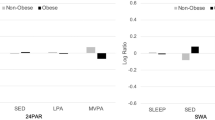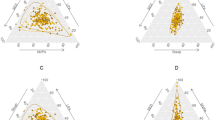Abstract
Background/objectives:
The 24 h day is made up of four movement behaviors: sleep, sedentary behavior (SB), light intensity physical activity (LIPA), and moderate-to-vigorous physical activity (MVPA). Previous studies examining associations between movement behaviors and obesity have used flawed statistical methods that did not account for the co-dependent and compositional nature of movement behaviors. Our objective was to use compositional data analysis methods to investigate the relationships between movement behaviors and obesity measures among children.
Subjects/methods:
Participants were 434 children aged 10–13 years. They wore an accelerometer for 7 days to determine time spent in SB, LIPA, and MVPA. Sleep duration was determined from the accelerometer and a log. The obesity measures were the body mass index, waist circumference, and fat mass index. Compositional data analysis was used to estimate whether the composition of movement behaviors was associated with obesity measures, and the extent to which changing time in movement behaviors within the movement behavior composition was associated with changes in obesity measures.
Results:
The composition of movement behaviors across the 24 h day was associated with all three obesity measures (p < 0.001). Relative to other movement behaviors, time spent in MVPA was negatively associated with obesity measures (p < 0.01), time spent in LIPA was positively associated with obesity measures (p < 0.05), while time spent in SB and sleep were not associated with obesity measures. The estimates suggested that an 18 min/day increase in MVPA, 21 min/day decrease in LIPA, 87 min/day decrease in SB, or 67 min/day increase in sleep relative to the remaining behaviors would be associated with a 0.1 unit decrease in BMI z-score.
Conclusions:
The composition of movement behaviors across the day is associated with obesity measures. The findings suggest that changing the movement behavior composition by increasing MVPA and decreasing LIPA would be the most effective approach for improving obesity measures.
This is a preview of subscription content, access via your institution
Access options
Subscribe to this journal
Receive 12 print issues and online access
$259.00 per year
only $21.58 per issue
Buy this article
- Purchase on Springer Link
- Instant access to full article PDF
Prices may be subject to local taxes which are calculated during checkout

Similar content being viewed by others
References
Poitras V, Gray C, Borghese M, Carson V, Chaput J-P, Katzmarzyk PT, et al. Systematic review of the relationships between objectively measures physical activity and health indicators in school-aged children and youth. Appl Physiol Nutr Metab. 2016;41:S197–S239.
Carson V, Hunter S, Kuzik N, Gray CE, Poitras VJ, Chaput JP, et al. Systematic review of sedentary behaviour and health indicators in school-aged children and youth: an update. Appl Physiol Nutr Metab. 2016;41:S240–65.
Chaput JP, Gray C, Poitras V, Carson V, Gruber R, Olds T, et al. Systematic review of the relationships between sleep duration and health indicators in school-aged children and youth. Appl Physiol Nutr Metab. 2016;41:S266–S82.
Saunders TJ, Gray CE, Poitras V, Chaput J-P, Janssen I, Katzmarzyk PT, et al. Combinations of physical activity, sedentary behaviour and sleep: relationships with health indicators in school-aged children and youth. Appl Physiol Nutr Metab. 2016;41:S283–S93.
Wilkie HJ, Standage M, Gillison FB, Cumming SP, Katzmarzyk PT. Multiple lifestyle behaviours and overweight and obesity among children aged 9-11 years: results from the UK site of the International Study of Childhood Obesity, Lifestyle and the Environment. BMJ Open. 2016;6:e010677.
Katzmarzyk PT, Barreira TV, Broyles ST, Champagne CM, Chaput JP, Fogelholm M, et al. Relationship between lifestyle behaviors and obesity in children ages 9-11: results from a 12-country study. Obesity. 2015;23:1696–702.
Pedišić Ž. Measurement issues and poor adjustments for physical activity and sleep undermine sedentary behaviour research – The focus should shift to the balance between sleep, sedentary behaviour, standing and activity. Kinesiology. 2014;46:135–46.
Pedišić Z, Dumuid D, Olds TS. Integrating sleep, sedentary behaviour, and physical activity research in the emerging field of time-use epidemiology: definitions, concepts, statistical methods, theoretical frameworks, and future directions. Kinesiology. 2017;49:1–18.
Dumuid D, Stanford TE, Martin-Fernandez JA, Pedisic Z, Maher CA, Lewis LK, et al. Compositional data analysis for physical activity, sedentary time and sleep research. Stat Methods Med Res. 2017;1:962280217710835. In press
Chastin SF, Palarea-Albaladejo J, Dontje ML, Skelton DA. Combined effects of time spent in physical activity, sedentary behaviors and sleep on obesity and cardio-metabolic health markers: a novel compositional data analysis approach. PLoS ONE. 2015;10:e0139984.
Aitchinson J. The Statistical Analysis of Compositional Data.. London: Blackburn Press; 2003.
Carson V, Tremblay MS, Chaput JP, Chastin SF. Associations between sleep duration, sedentary time, physical activity, and health indicators among Canadian children and youth using compositional analyses. Appl Physiol Nutr Metab. 2016;41:S294–302.
Fairclough SJ, Dumuid D, Taylor S, Curry W, McGrane B, Stratton G, et al. Fitness, fatness and the reallocation of time between children’s daily movement behaviours: an analysis of compositional data. Int J Behav Nutr Phys Act. 2017;14:64.
Colley R, Gorber SC, Tremblay MS. Quality control and data reduction procedures for accelerometry-derived measures of physical activity. Health Rep. 2010;21:63–9.
Payau MR, Adolph AL, Vohra RA, Butte NF. Validation and calibration of physical acitivity monitors in children. Obes Res. 2002;10:150–7.
de Onis M, Onyango AW, Borghi E, Siyam A, Nishida C, Siekmann J. Development of a WHO growth reference for school-aged children and adolescents. Bull World Health Organ. 2007;85:660–7.
Dulloo AG, Jacquet J, Solinas G, Montani JP, Schutz Y. Body composition phenotypes in pathways to obesity and the metabolic syndrome. Int J Obes. 2010;34:S4–17.
Mirwald RL, Baxter-Jones AD, Bailey DA, Beunen GP. An assessment of maturity from anthropometric measurements. Med Sci Sports Exerc. 2002;34:689–94.
Janssen I, Leblanc AG. Systematic review of the health benefits of physical activity and fitness in school-aged children and youth. Int J Behav Nutr Phys Act. 2010;7:40.
Mark AE, Janssen I. Influence of bouts of physical activity on overweight in youth. Am J Prev Med. 2009;36:416–21.
Ness AR, Leary SD, Mattocks C, Blair SN, Reilly JJ, Wells J, et al. Objectively measured physical activity and fat mass in a large cohort of children. PLoS Med. 2007;4:476–84.
Guerra S, Teixeira-Pinto A, Ribeiro JC, Ascensao A, Magalhaes J, Andersen LB, et al. Relationship between physical activity and obesity in children and adolescents. J Sports Med Phys Fit. 2006;46:79–83.
Goran MI. Measurement issues related to studies of childhood obesity: assessment of body composition, body fat distribution, physical activity, and food intake. Pediatrics. 1998;101:505–18.
Acknowledgements
We would like to thank the participants for their commitment to the study, the project coordinator, and the many students who assisted with data collection, processing, and cleaning.
Funding
This research was funded by a grant from the Heart and Stroke Foundation of Canada.
Author information
Authors and Affiliations
Corresponding author
Ethics declarations
Conflict of interest
The authors declare that they have no conflict of interest.
Electronic supplementary material
Rights and permissions
About this article
Cite this article
Talarico, R., Janssen, I. Compositional associations of time spent in sleep, sedentary behavior and physical activity with obesity measures in children. Int J Obes 42, 1508–1514 (2018). https://doi.org/10.1038/s41366-018-0053-x
Received:
Revised:
Accepted:
Published:
Issue Date:
DOI: https://doi.org/10.1038/s41366-018-0053-x
This article is cited by
-
The association between reallocations of time and health using compositional data analysis: a systematic scoping review with an interactive data exploration interface
International Journal of Behavioral Nutrition and Physical Activity (2023)
-
Applying the COM-B model to understand wearable activity tracker use in children and adolescents
Journal of Public Health (2023)
-
Sociodemographic differences in 24-hour time-use behaviours in New Zealand children
International Journal of Behavioral Nutrition and Physical Activity (2022)
-
Many different roads lead to Rome: equivalence of time-use for activity, sedentary and sleep behaviours and dietary intake profiles among adolescents
Journal of Activity, Sedentary and Sleep Behaviors (2022)
-
Associations of neighborhood walkability with moderate to vigorous physical activity: an application of compositional data analysis comparing compositional and non-compositional approaches
International Journal of Behavioral Nutrition and Physical Activity (2022)



